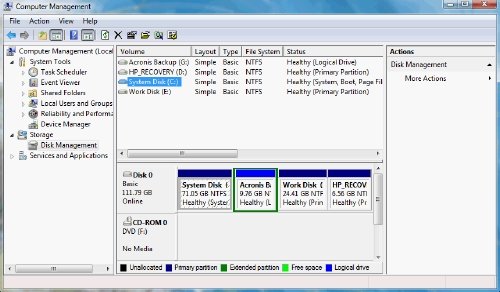To use the Disk Management Tool, simply follow these steps. Click Start > Right Click on Computer > Select Manage. In the left pane, under Storage category, click on Disk Management. Now select and right-click on the partition you wish to modify. In the context menu, you will see options to Extend, Shrink, or Delete the partition. Select the option you want. You cannot merge partitions in Windows with this utility. If your 2nd partition is empty, you can delete the 2nd partition and then extend the 1st partition, to use the freed-up space. Also, note that you can extend only to the right; if you are desirous of extending the partition to the left, you may have to use a 3rd party tool. You can read more here about the Disk Management Tool. Sometimes one or more options may be grayed out and thus unavailable. If this happens, it could mean that such a step may not be physically possible. You can resize a Partition even if Disk Management fails using DISKPART and FSUTIL command-line tools for Disk Management in Windows 10.
Resize a Partition in even if Disk Management fails
It may happen that the Disk Management tool may fail to complete an operation successfully. Should you wish to continue, nevertheless, please first backup your important data should anything go wrong. You may have to use diskpart.exe.
Diskpart Utility
The Diskpart utility can do everything that the Disk Management console can do, and more! It’s invaluable for scriptwriters or anyone who simply prefers working at a command prompt. Among several other things, you can use Diskpart to do the following:
Convert a basic disk to a dynamic diskConvert a dynamic disk to a basic disk.Create a partition at an explicit disk offset.Delete missing dynamic disks.
Enter diskpart in the Start search bar and hit Enter. A ‘command prompt’ like window will open. Type list disk and hit Enter. This will show you a list of all your hard disks. Now type select disk
Example :
To extend size by 5GB, type Extend size=5000 To shrink the volume by minimum 1GB, up to a maximum of 5 GB, type, Shrink desired=5000 minimum=1000 You can even delete a partition by typing, Delete Partition and hitting Enter.
Fsutil Utility
Windows also includes an additional command-line tool for file, system, and disk management, called Fsutil. This utility helps you to change the short name of a file, find files by SID’s (Security Identifier) and perform other complex tasks. FSUtil and Diskpart are powerful, but not for inexperienced Windows user. So do be careful, please.
There is not enough space available on the disk(s) to complete this operation
What do you do if you get the message – There is not enough space available on the disk(s) to complete this operation? Most new computers with OEM Windows pre-installs come with 4 partitions. Hard disks configured as basic disks are limited to 4 primary partitions or 3 primary partitions and 1 extended partition and multiple logical drives. And as such, if you try to shrink the OS partition, you may find that you cannot create a 5th partition due to this limit. There could be two possible solutions for this issue: Deleting the partitions created by the OEM is often not possible due to the way the OEMs configure the partitions. Therefore the option then is to extend the operating system partition back to the original size to regain use of the unallocated space. If additional storage is needed, consider adding an external USB hard disk.
